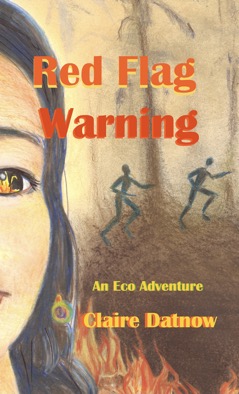YA Eco Mysteries, Memoirs, Novels & Travel
Environment and Ecology
Searching for Ways to Introduce Climate Change
18/11/21 11:01 Filed in: Environmental Education
Searching for Ways to Introduce Climate Change?
Melting Ice in The Antarctic_Boris Datnow
Since climate change will impact daily life—now and in future—it is both a critical problem that needs to be addressed and one that can be adapted to effective teaching, across the curricular. Science-based information, methods, and resources help educators broach this complex subject, no matter what area they teach.
Understanding the impact of climate change is an essential step toward preparing our students to become knowledgeable, active, and just stewards of our state’s and our planet’s natural environment adversely impacted by climate change.
For Free Teacher Handouts and Lessons Plans visit: mediamint.net:
Teaching Environmental Science/Climate Change/ Through Fiction.
Fiction can be a powerful way for students to understand how climate change has and will impact their future. Fiction is one way (cli-fi) can serve as a springboard for lively discussions. In addition, stories offer ways in which students can envision and adjust to climate change.
Links to Additional Resources.
Climate Change Fiction for Kids: https://mediamint.net/page7/files/Climate%20Change%20Fiction%20for%20Kids.html
Red Flag Warning: An Eco Adventure by Claire Datnow

YA/Teen Eco Fiction. https://mediamint.net/page7/files/Teen%20Eco%20Fiction.html
The Winds of Change: Children’s Environmental Climate Fiction: https://dragonfly.eco/the-winds-of-change-childrens-environmental-climate-fiction/
INTERVIEW: CLIMATE CHANGE FOR TEENS
https://mediamint.net/page7/files/Interview:%20Climate%20Change%20for%20Teens.html
Climate Change Fiction: Multicultural, Diverse, Global, and with Animals, Too! a guest blog by author Claire Datnow: https://www.teenlibrariantoolbox.com/2021/03/climate-change-fiction-multicultural-diverse-global-and-with-animals-too-a-guest-blog-by-author-claire-datnow/
Interview with Mary Woodbury Climate Fiction:
https://dragonfly.eco/indie-corner-claire-datnow/
How To Teach Climate Change Without Panicking Your Students: https://blog.planbook.com/teach-climate-change/
Melting Ice in The Antarctic_Boris Datnow
- Why Teach Climate Change?
Since climate change will impact daily life—now and in future—it is both a critical problem that needs to be addressed and one that can be adapted to effective teaching, across the curricular. Science-based information, methods, and resources help educators broach this complex subject, no matter what area they teach.
Understanding the impact of climate change is an essential step toward preparing our students to become knowledgeable, active, and just stewards of our state’s and our planet’s natural environment adversely impacted by climate change.
- Ways to Introduce Climate Change: Instead of burdening educators with additional stand-alone, complex areas to study, the good news is that Environmental Literacy can become a part of subjects and activities already in your state’s core curriculum standards in science, math, social studies, and language arts.
- Climate Fiction: As Earth’s changing climate becomes an ever-increasing concern, young readers are turning to climate fiction as a way to engage their imaginations and deal with their fears in the safety of their present environment. The teens in these climate fiction stories demonstrate courage, tenacity, compassion, imagination, and foresight. So, although the events may be upsetting, the reader empathizes with the main characters and finish the last page feeling informed, hopeful, resolute, and inspired.
- Connecting Scientific Concepts with Fiction/Storytelling can be a powerful way to make future consequences more immediate to ourselves and our students. Fiction can be woven into teaching environmental science and climate change as outlined in the core curriculum standards
For Free Teacher Handouts and Lessons Plans visit: mediamint.net:
Teaching Environmental Science/Climate Change/ Through Fiction.
Fiction can be a powerful way for students to understand how climate change has and will impact their future. Fiction is one way (cli-fi) can serve as a springboard for lively discussions. In addition, stories offer ways in which students can envision and adjust to climate change.
- After reading appropriate fiction, Language Arts teachers can Inspire Lively discussions by interweaving the Theme of Climate Change.
- Social Studies Teachers and can Inspire Lively discussion around the impact of Climate change on marginalized groups in their own communities and around the globe (Social Justice).
Links to Additional Resources.
Climate Change Fiction for Kids: https://mediamint.net/page7/files/Climate%20Change%20Fiction%20for%20Kids.html
Red Flag Warning: An Eco Adventure by Claire Datnow

YA/Teen Eco Fiction. https://mediamint.net/page7/files/Teen%20Eco%20Fiction.html
The Winds of Change: Children’s Environmental Climate Fiction: https://dragonfly.eco/the-winds-of-change-childrens-environmental-climate-fiction/
INTERVIEW: CLIMATE CHANGE FOR TEENS
https://mediamint.net/page7/files/Interview:%20Climate%20Change%20for%20Teens.html
Climate Change Fiction: Multicultural, Diverse, Global, and with Animals, Too! a guest blog by author Claire Datnow: https://www.teenlibrariantoolbox.com/2021/03/climate-change-fiction-multicultural-diverse-global-and-with-animals-too-a-guest-blog-by-author-claire-datnow/
Interview with Mary Woodbury Climate Fiction:
https://dragonfly.eco/indie-corner-claire-datnow/
How To Teach Climate Change Without Panicking Your Students: https://blog.planbook.com/teach-climate-change/



